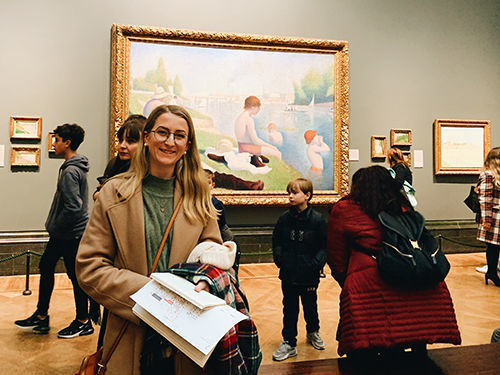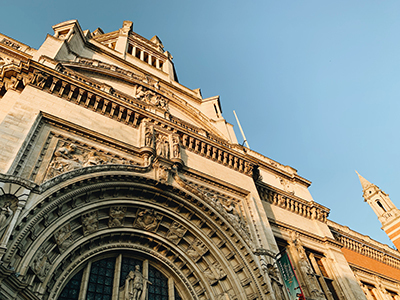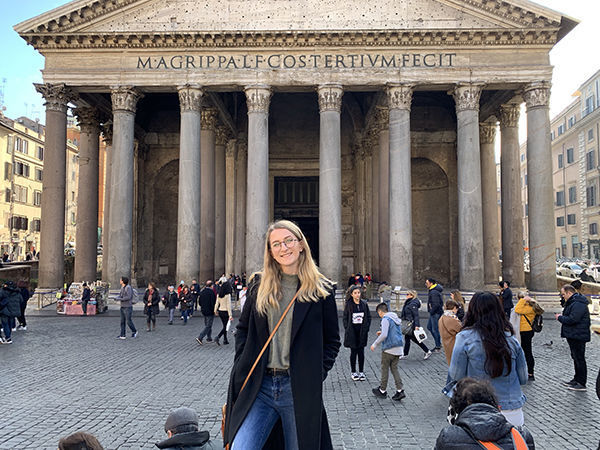
Notre Dame School of Architecture graduate Mary Lewis ’20 traveled to London and Rome last winter to study the relationship between art and architecture in European art museums. She sought to understand how art museums in Europe developed and changed over time in order to arrive at the state in which they exist today.
This article is part of a series of blog posts published by the Nanovic Institute for European Studies. The Nanovic Navigator is home to stories told by students about their unique experiences in Europe through Nanovic student grant programs. If you have questions about a story, a student, or the Nanovic Institute, please contact Anna Dolezal, student programs assistant manager (adolezal@nd.edu).

Art museums, their contents, and their architectural design are rarely discussed in relation to each other. Their effective coordination, however, is crucial to the success of the art museum as an institution of both teaching and preservation. Existing literature examining the dynamic between museums and architecture fails to discuss the ways people interact with the art itself as a result of the design and, consequently, the museum’s overall effectiveness.
European art museums are historically based on the model of retrofitting palaces, factories, or other civic buildings to become art galleries. Because these museums were not initially designed for their current purpose, the discussion remains to be had about the relative effectiveness of this museum model compared to that of the American museum, which is generally designed to be a museum from the moment of conception.
My research explores how changes in museum design affect viewers’ perceptions of the art exhibited. The art museum is intended to be a teaching and preservation entity, but how does it continue to be valued as an educational institution while visitors can easily access even more information through the Internet? What continues to bring people to art museums? How can these institutions continue to evolve?
This research is greatly relevant to those looking to improve the designs of these institutions. Museum directors work to improve their attendance rates through the implementation of interesting new exhibits and technological improvements, but what if their institutions could become more successful through foundational improvements of the design of their facilities overall? They are working to solve symptomatic responses to an underlying cause—the architectural design.This research is also deeply relevant to my own work. In order to effectively design a progressive new art museum this past spring for my architecture thesis project, I had to develop an understanding of proper historic precedents and why art museums have evolved to become the way they exist today.

By travelling to London for four days and to Rome for five days, I was able to reach answers to the questions I posed about European art museum design through both observational and analytical methods. With funding from a Nanovic Institute Break Travel & Research grant, I actualized an itinerary that afforded me the ability to visit either one large or two small museums each day in both London and Rome. My goal was to understand the ways in which art museums in Europe developed and changed in order to arrive at the state in which they exist today.
Upon arrival, I utilized floor plans I prepared ahead of time. I also brought with me the maps and guides provided by the museum itself as a means of analyzing the spaces as I moved through them. I took copious notes and was asking questions of everything I saw. I asked "Why?" about every room shape, every hallway, every window, and every placement of artwork. I took countless pictures and was constantly sketching ideas. I spoke with people who worked in each museum about its history and how they believe it functions. I was looking at the ways people interacted with the art, how visitors navigated through the museums, and the ways the museums had evolved to create the highly acclaimed learning environments they are today. I was also looking for ways they were unsuccessful—confusing galleries and narratives, poor display methods, bad lighting—in order to aid in my own development of a contemporary art museum design for my architecture thesis project.
After spending eight hours inside the Victoria and Albert Museum in London, speaking with people and exploring every inch of it, I came to the conclusion that this museum would be the ultimate precedent study for me and my own thesis work. The museum was the perfect example of how museums have grown and changed, and how educational intent can shine through design. Victoria and Albert was designed for the purpose of education of the everyday person as well as artists. Its spaces are organized in specific ways to teach a narrative—whether chronologically, or through medium or style—to visitors as they make their way through galleries. This method of teaching visitors through design is also utilized at the Vatican Museum in Rome.

I was also able to experience how European museums were originally designed, such as the Cabinet of Curiosities method. This method, used in museums such as the Sir John Soane Museum in London and the Capitoline Museum in Rome, are characterized by small private collections of seemingly random assortments gathered together in one space and made available to the public. Another method is that of the salon style, exemplified in the Tate Britain in London and Villa Doria Pamhilj in Rome. In these spaces, each artwork was seen as part of a greater composition on the wall rather than individually valued works to be enjoyed one-by-one. The composition of the artworks themselves created a greater piece and defined the space—thus determining the way they are often displayed in museums, filling the wall stacked from floor to ceiling.
This experience has been a priceless aid to my studies at Notre Dame. It has formed the foundation of my understanding of the architecture of European art museum design and has given me the ability to compare European and American art museums in a critical manner, both from experience of the spaces and analysis of the designs.
Originally published by at nanovic.nd.edu on September 08, 2020.